Blog
The future of outdoor
This article is a reprint from Mediaweek, author: Stephen Armstrong

Posters that can recognise your face and live video streaming on car windows are just two of the technologies transforming out-of-home into the most targeted advertising medium in town.
If you’re working in the out-of-home industry it can feel a bit as though all the other media are getting the fun new tech stuff – 3D interactive TV, smartphone apps or, indeed, anything Steve Jobs turns his poloneck-supported mind to.
So it has been something of a relief to outdoor practitioners that the Israeli defence industry moves its new gadgets from the military to the commercial sector every now and then.
Take face recognition software, for instance – originally designed to identify terror suspects, it has been creeping into digital posters, initially as a research tool but with the potential to create almost individually targeted creative work.
And face recognition is just the tip of the new tech iceberg when it comes to outdoor innovation – live video, augmented reality, live tweeting, interactive gaming and 3D posters are all rolling out across the high street and the shopping malls. There is even an iPhone opportunity.
“Advertising is increasingly about the personal – interactive TV, online tailored messages – and outdoor is traditionally a broadcast medium,” explains Ivan Clark, independent outdoor specialist and blogger.
“What you’re seeing with these new technologies – although they won’t hit the mainstream for a while – is the chance for outdoor to become as tailored as almost any other medium.”
Clark points to a campaign for Becks that Starcom booked in niche, hip districts of London like Hoxton and Brixton (see gallery). Passers-by could plug their iPod into the intelligent digital screens, and software developed by Outsideline produced an artwork in response to the music, which was then sent to Twitter and Flickr sites where the image could be downloaded.
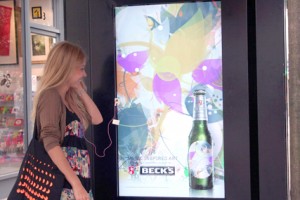 Over two weeks, there were 10,000 interactions with the digital posters, 2,500 people accessed the Flickr images and Shoreditch scenesters were even forming queues to use the posters outside some sites.
Over two weeks, there were 10,000 interactions with the digital posters, 2,500 people accessed the Flickr images and Shoreditch scenesters were even forming queues to use the posters outside some sites.
Pip Hainsworth, marketing director for Clear Channel in the UK, was struck by an election campaign in support of the Conservative Party – galvanised by a group of volunteers led by Engine and WCRS president Robin Wight – where Twitter comments were fed live onto LED screens for minute-by-minute commentary on the issues of the day.

Another groundbreaking piece of advertising was the world’s first 3D outdoor campaign from Twentieth Century Fox for the film Percy Jackson and the Lightning Thief, where a bespoke trailer ran on 42″ HD screens installed in bus shelters on Oxford Street and in Kensington.
Cameron Saunders, UK marketing director for the theatrical division of Twentieth Century Fox, says: “In the past 18 months, digital outdoor has moved on in leaps and bounds. In a world where consumers are being bombarded with competing messages, this is something no-one could fail to be absorbed by.”
Never forget a face
Hainsworth is currently expanding on recent research using face recognition technology, run jointly with Kinetic. The first run of the research – conducted earlier this year – placed cameras behind posters in the Westfield Royal Victoria Place shopping mall in Tunbridge Wells and measured how often consumers checked out the poster, what age and sex they were and what mood they were in, based on how happy or sad they looked.
The study found that shoppers were more relaxed – and thus more disposed to view advertising – at the weekend. The highest levels of eye-contact took place on Sunday lunchtime, while the group most likely to check the poster out were younger passers-by and women.
“This was a research project, but it could lead to a change in creative execution,” says Kinetic’s global marketing director Nick Mawditt. “We have the software and the connections to enable us to change execution centrally very quickly.
“It is theoretically possible to spot crowd changes – for example greater numbers of women or teenagers – and instantly alter your creative as a result. You can certainly already change executions according to daypart and consumer mood, which means highly responsive advertising.”
In other words, digital posters could soon be able to change to suit your tastes. The poster might be able to alter its shape or size to draw you in, it could feature holographic imagery, or you might be able to browse a drop-down menu on the side of the screen and send details such as a money-off coupon to your Facebook account.
And in the rare instance where passers-by aren’t attracted to the poster, the digital cameras that measure footfall and dwell-time minute by minute can simply change copy at the flick of a switch.
Matching media to mood
Over in Israel, where face-recognition began, Dani Zeevi, co-founder and chief executive of YCD Multimedia is already going further. The company offers services ranging from tracking to creative solutions that follow consumers from outside the store to point-of-sale.
In fast-food joints, for instance, cameras track queues of consumers and software matches daypart to mood and menu, so digital screens offering price and choice can change almost minute by minute.
“Retailers want to keep queues down and customers happy,” Zeevi explains. “Our algorithms allow them to offer the most popular items at the right time with changes in price according to offers and mood.
“We’ve worked with Toyota, Wimpy and fashion chains to cover the link from brand advertising to the till. The UK is lagging a little behind other parts of the world, but as the recession ends we can see that changing.”
Some, however, believe it’s not just the recession that’s keeping the industry cautious. James Davies, director of Posterscope’s future-facing division Hyperspace, says: “There are so many technological developments that can be applied to OOH campaigns and these are evolving so quickly it’s difficult for media owners to make investment choices with confidence.
“Also, clients often want technology applied to locations of their choice, as opposed to those that have been predetermined by media owners.”
Davies recently collaborated with digital agency Profero on the launch of the new Mini Countryman (see gallery), where video footage of passers-by was projected onto the inside of the car, as if they were squeezed inside the vehicle, and the results shared on Facebook.
He is also enthusiastic about new applications from areas such as architecture and public art. For example, he cites the “emotional cities” art project where buildings are lit in different colours depending on the “mood of the city”, as measured by prevailing online activity, and the Tesla coils used to create artificial lightning bolts at Glastonbury.
However, he warns: “It’s easy to get carried away with what’s technically possible, but agencies should always ensure the consumer is the core consideration. For example, one of the reasons that QR codes – barcodes that when photographed open a mobile website – didn’t become mainstream years ago is that most campaigns didn’t include a suitable consumer education element. Indoor or outdoor, you have to start with the consumer.”
‘Out there’ outdoor: five next-generation advertising formats
Augmented reality screens embedded into poster sites, as offered by JCDecaux.
An augmented outdoor mobile app that overlays hidden content and reward onto poster sites when viewed through a camera phone, as offered by Posterscope and The Cloud and Compass.
Moderated live streaming from Twitter and Facebook to OOH screens (campaign for AT&T in location and Facebook page below), as offered by LocaModa (based in the US).
Clic2C technology, as demonstrated by CBS Outdoor, that allows any printed poster to become interactive by opening a free phone application that works on most handsets including iPhone, Android, BlackBerry and Nokia. By pointing the phone’s camera at the poster, consumers are automatically linked to a mobile website.
Magic Mirror screens in-store that allow shoppers to see what they would look like ‘wearing’ various items of clothing from the rack, reducing changing-room space and time, as offered by C-InStore.

Sao Paolo advertising goes underground
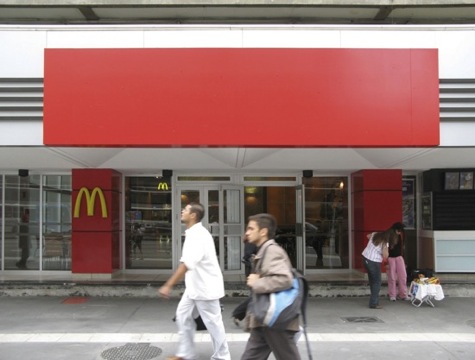 Source: Financial Times (www.ft.com, author: Vincent Bevins)
Source: Financial Times (www.ft.com, author: Vincent Bevins)
Four years ago, the streets of São Paulo, South America’s biggest city, were strewn with advertising. Messages on the surfaces of buildings, buses, shops, taxis and even private homes competed with billboards to create a chaotic and dizzying corporate assault on the senses.
So, Gilberto Kassab, the centre-right mayor of the city with the continent’s biggest consumer market, came up with a radical solution: a blanket ban on outdoor advertising. In late 2006, in spite of legal wrangles and business lobbying, he announced that, almost without exception, outdoor advertising would have to be removed within months.
“The Clean City Law came from a necessity to combat pollution . . . pollution of water, sound, air and the visual,” he said. “We decided that we should start combating pollution with the most conspicuous sector – visual pollution.”
At the time, advertising and marketing executives feared the ban would be an insurmountable blow, and quietly hoped the law would not be fully enforced. Industry representatives protested that the ban would limit freedom of speech, kill jobs and badly damage their sector.
“We all thought it was the end of the world,” says Marcio Oliveira, vice-president of operations at Lew’Lara\TBWA. “We thought, ‘OK, this is gonna screw up all our business.’ ”
Three years after the new law came in, it is extremely difficult to find outdoor advertising in the city – no billboards, no ads on buses or taxis or in shop windows. But equally remarkable is how quickly big advertisers and the industry itself have adapted and, in fact, thrived.
Today, it is hard to find anyone – including among advertising and marketing professionals – who still has big complaints about the Lei Cidade Limpa, or “Clean City Law”.
The city feels cleaner, they say, and the law forced creative innovations into other, newer, advertising methods that have often been more effective. “In the first instance, everybody, including the advertisers, loved this – to see their city without this visual pollution we had in the past,” says Mr Oliveira.
“I think it’s a good law,” says Nizan Guanaes, head of Grupo ABC, Brazil’s largest advertising group. “It was a challenge for us because, of course, it’s easier to simply throw garbage advertising all over your city.”
Márcio Santoro, co-president of Agência Africa, part of Grupo ABC, says that before the law, “it was really a mess. It was terrible. There came a point that for you to be noticed you had to buy a lot of ads, because there was so much noise.”The law is now so popular that some companies that were able through legal action to maintain some outdoor presence chose not to, so as not to be seen as flying in the face of Cidade Limpa.
Advertising creatives and marketing directors were forced quickly to find new ways to spend money that had been earmarked for outdoor advertising, especially since the law came into effect almost immediately. “Usually in Brazil it takes a little time for laws to get set up,” says Marcello Queiroz, an editor at Propaganda and Marketing newspaper in São Paulo. “It was really dramatic how quick things changed. Big companies had to change their focus and strategies.” Marketing directors had to find a place to spend the money they previously put into billboards. The result, they say, was a creative flowering of new and alternative methods – including indoor innovations such as elevator and bathroom ads – but primarily in digital media. “The internet was the really big winner,” says Mr Oliveira. In 2007, there was already a move towards the internet, digital media and social networking marketing worldwide, but the Cidade Limpa law gave Brazilians an extra push, he says.
Anna Freitag, marketing manager of Hewlett-Packard Brazil, says a realisation came that outdoor advertising is less effective than these newer strategies. “A billboard is media on the road. In rational purchases it means less effectiveness . . . as people are involved in so many things that it makes it difficult to execute the call to action,” she says. “HP decided to go deeper and understand consumer behaviour – the path to purchase, and place media in this direction . . . The internet and social media are the big trends associated with point of sale presence.” It also helped that Brazilians were extremely active in social media. The country has one of the highest percentages of active Twitter users in the world and Brazilians are avid social networkers. Lalai Luna, co-founder of Remix, a new agency specialising in digital and social media strategies, often focusing on music culture, says this opened up opportunities and cash flow for young creatives with experimental models to develop their craft. “Companies had to find their own ways to promote products and brands on the streets,” she says. “São Paulo started having a lot more guerilla marketing [unconventional strategies, such as public stunts and viral campaigns] and it gave a lot of power to online and social media campaigns as a new way to interact with people.”
“The internet is the next frontier for reasons I don’t have to explain,” says Mr Guanaes. “Brazil is very sophisticated in digital and social media. That’s why we have a digital agency in the US [San Francisco’s Pereira & O’Dell] and it just won the Advertising Age award for best small agency in the US.” The Clean City Law has thrown up winners as well as losers. The businesses and workers that dealt directly with in stalling and removing billboards have not benefited from the boom in digital marketing, but the move has certainly not stopped Brazilian agencies from being the focus of much international attention.
Publicis, the world’s third largest advertising group, is in the advanced stages of negotiation to buy Talent, a São Paulo agency, for a high price that underlines how highly international companies value getting a foothold in the Brazilian market.
And some international brands are choosing Brazil as a global hub for campaigns. Mr Oliveira says Lew’Lara\TBWA is creating Visa’s global campaign for its sponsorship of Fifa events in Brazil, including the World Cup, which will be exported abroad.
The plan was probably never to maintain a complete ban on all outdoor advertising for ever. The expectation was that the law would sweep the city clean and later allow for some outdoor advertising in a small number of controlled locations.
But, three years after the implementation of Lei Cidade Limpa, few are clamouring for a return to those cluttered days.
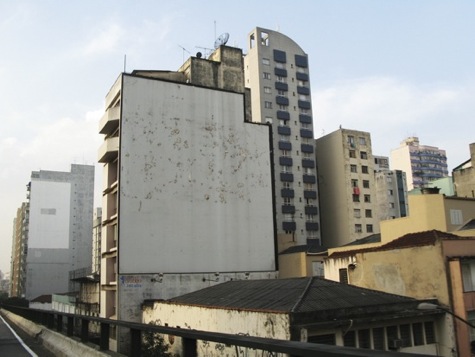
Wonderbra: 3D billboard
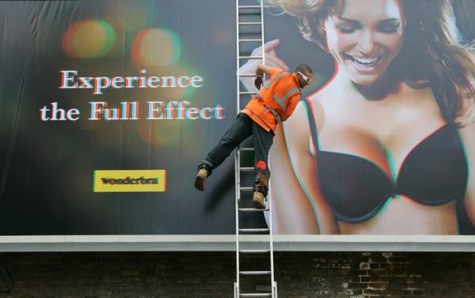 Wonderbra in the UK has unveiled its first 3D billboard poster that marks the launch of an integrated campaign by iris to promote its new Full effect bra. The 48-sheet poster kick starts a range of brand engagement initiatives to span digital, experiential, media partnerships and PR, which will work together to put the brand directly in touch with its female target audience. The poster, at Waterloo Road London, features a model wearing the bra and can be viewed with specially designed 3D glasses in the shape of the bra. The guerrilla stunt was created by iris to generate buzz around the new bra, which can boost busts by up to two-cup sizes.
Wonderbra in the UK has unveiled its first 3D billboard poster that marks the launch of an integrated campaign by iris to promote its new Full effect bra. The 48-sheet poster kick starts a range of brand engagement initiatives to span digital, experiential, media partnerships and PR, which will work together to put the brand directly in touch with its female target audience. The poster, at Waterloo Road London, features a model wearing the bra and can be viewed with specially designed 3D glasses in the shape of the bra. The guerrilla stunt was created by iris to generate buzz around the new bra, which can boost busts by up to two-cup sizes.
The campaign, called Full effect your life, will see Wonderbra give three girls the opportunity to win one of three life-enriching experiences**: Become a fashion journalist with a weeks internship at Cosmopolitan.co.uk; discover the secrets of a fashion stylist by shadowing Grace Woodward of Britains Next Top Model; or delve into the mind of a fashion buyer on a trip to Paris with leading vintage site WeLoveVintage. An online and PR campaign kick off the nationwide competition today, with an exclusive feature in The Sun including a giveaway of the limited edition Full effect 3D glasses, as well as social media content to go live on Facebook and Twitter. All activity will drive traffic to the campaigns dedicated competition website within www.wonderbra.co.uk, created by iris. The site was sourced by MPG.
The commercial titled 3D billboard was done for WONDERBRA (WONDERBRA company) in United Kingdom. It was released in the September 2010. Business sector is Clothing & footwear.
source: www.coloribus.com
Tenders planned for Amsterdam outdoor advertising products
2. lamppost advertising (contract until December 31, 2010)
3. advertising in subway stations (contract until December 31, 2011)
4. bus shelters and mupi’s (contract until July 1, 2012) The public procurement for the first two projects will be launched soon (May), besides of course the town is preparing to other projects. Contract party on behalf of the municipality is the Infrastructure and Traffic Authority (DIVVl). The tenders will be announced through the procurement calendar.
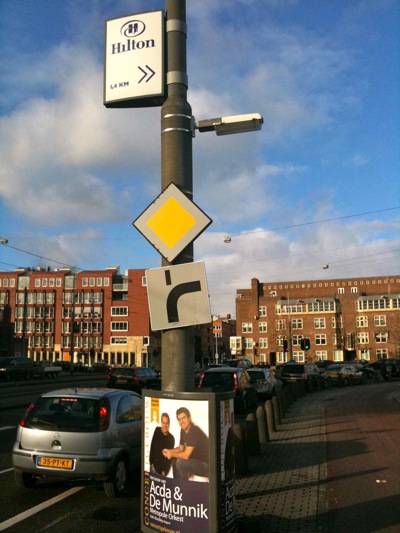
Digital Billboards, Diversions Drivers Can’t Escape
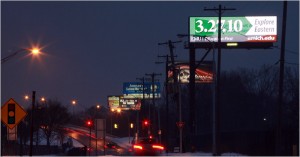 Safety advocates who worry about the dangers of distracted driving have a new concern beyond cellphones and gadget-laden dashboards: digital roadside billboards.
Safety advocates who worry about the dangers of distracted driving have a new concern beyond cellphones and gadget-laden dashboards: digital roadside billboards.
These high-tech billboards marry the glow of Times Square with the immediacy of the Internet. Images change every six to eight seconds, so advertisers can flash timely messages — like the latest headlines, coffee deals at dawn, a cheeseburger at lunchtime or even the song playing on a radio station at that moment.
The billboard industry asserts there is no research indicating they cause crashes, and notes that the signs do not use video or animation.
But to critics, these ever-changing, bright billboards are “television on a stick” and give drivers, many of them already calling and texting, yet another reason to take their eyes off the road.
Abby Dart, executive director of Scenic Michigan, a nonprofit group trying to block construction of new digital billboards in the state, calls the signs “weapons of mass distraction” and says they can be more dangerous than phones.
“You can turn off your phone,” she said. “The billboard gets your attention whether you want to give it or not.”
Last Thursday, Michigan lawmakers held hearings on legislation, the first of its kind, that would impose a two-year moratorium on the construction of new billboards. Minnesota’s legislature is scheduled to hold hearings this month on a similar moratorium. As digital billboards begin to pop up around the country, questions about whether to regulate the emerging technology are being asked in other states as well, and by federal officials.
The Federal Highway Administration has been conducting a study, which it says will be completed this summer, that uses eye-trackers inside cars to see whether drivers who have volunteered for the study look at the digital billboards, and for how long. The agency also has organized a tour this spring to take researchers to various cities around the world to study how other nations are regulating digital billboards.
In the United States, only about 2,000 of the nation’s 450,000 billboards are digitized, but the industry expects there to be tens of thousands of them, as many as 15 percent of its overall inventory.
The signs are typically used in busy traffic areas, where advertisers are willing to pay a premium for them. A digital billboard costs $250,000 to $300,000, roughly half what it did five years ago, but much more than the $5,000 to $50,000 for a traditional billboard.
Space on the digital signs fetches a premium in part because up to six advertisers can share a single location. Traditional billboards fetch a wide range of monthly rents (from $1,000 to $5,000 depending on location and audience) and the digital versions cost the same or a bit more, but the industry benefits by selling that space at that price to more than one advertiser.
Rather than settling the matter, existing research about digital billboards leaves room for debate on the danger.
One 2007 study, from the Virginia Tech Transportation Institute, which used in-car cameras to study motorists, found that digital billboards did not change driver behavior more than ordinary billboards.
But critics note that the study was financed by the billboard industry and that it was found to be biased by reviewers who rejected it for publication in 2008 by the Transportation Research Board, a Congressionally chartered agency.
Even the researcher who led the Virginia Tech institute project, Suzanne Lee, while defending her science as sound, said that the potential for drivers to be distracted by the new billboards — and digital signs that use video and animation — should be investigated further.
“If we don’t study this, and get on top of it right now while the capabilities are expanding, every roadway will be filled with flashing lights and video,” said Ms. Lee.
For decades, the Federal Highway Administration has provided regulations to states governing free-standing billboards that prohibit them from having “flashing, intermittent or moving light or lights.”
But in 2007, the agency ruled that the free-standing digital billboards did not violate the rule and recommended, among other guidelines, that ads on those billboards stay in place at least four seconds and that they not be “unreasonably bright.”
Last week, the Georgetown Institute for Public Representation, a public interest law group, filed a petition with the highway administration asking it to reverse the earlier decision, which would have the effect of banning new digital billboards that include flashing, intermittent or moving lights, and requiring the dismantling of existing ones.
The billboard industry argues that the new signs are part of a larger technological and economic shift to a paperless society (no more crews hoisting and removing ads from billboards) and that they give advertisers more flexibility.
Marketing materials published last year by Clear Channel, one of the nation’s biggest billboard companies, say the digital billboards are, among other things, ideal for posting game scores by advertisers like radio stations and sports bars. News organizations can also use them — “as the Web site headline changes, so does the digital billboard,” the materials say.
”It’s a very flexible, very responsible medium and very impactful,” said Ron Cooper, chief executive of Clear Channel Outdoor, which has 450 digital billboards and plans to add 150 more this year. Big corporations that have used them include ABC, AT&T, Coca-Cola,McDonald’s, General Mills, Ford and Verizon. “Consumers report seeing it, remembering the brand, remembering the advertisers.”
He and others in the industry say they have been careful to make the signs memorable but not distracting. They say the “television on a stick” label is an exaggeration.
“It’s a slide projector — it shows one image after the next,” said Bill Ripp, a vice president who oversees digital billboards for Lamar Advertising, another large billboard company. “We were as concerned as anybody. We wouldn’t want to cause danger.”
The industry has found an ally in some crime-fighting groups and agencies, including the Federal Bureau of Investigation and the National Center for Missing and Exploited Children, which use the new signs to broadcast images of fugitives or of abducted children.
“We’ve had moms grab their sons by the ear and drag them right down to the sheriff’s office because they were embarrassed to see the son on the billboard,” said Bart Dexter, coordinator of the Michigan Crime Stoppers organization, who opposes the Michigan moratorium.
Ms. Dart, from Scenic Michigan, said the potential driver distraction outweighs any help the signs may provide in catching fugitives.
Rebekah Warren, a Democratic state representative from Ann Arbor, who proposed the moratorium, said the bill reflected broader concerns that legislators around the country had about distracted driving. In December, the Michigan House of Representatives passed legislation banning motorists from texting, something its Senate now is considering.
“We are moving so quickly into this digital age,” said Ms. Warren. “We are being cautious in state legislatures around the country on how we keep drivers focused on the road.”